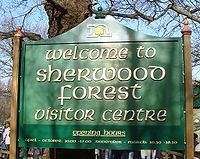 | ||
Similar | ||
Family activity breaks uk sherwood forest nottinghamshire center parcs
Sherwood Forest is a royal forest in Nottinghamshire, England, famous by its historic association with the legend of Robin Hood.
Contents
- Family activity breaks uk sherwood forest nottinghamshire center parcs
- Map of Sherwood Forest Mansfield UK
- Discover center parcs sherwood forest nottinghamshire holiday village
- Management and conservation
- Tourism
- Major Oak
- Thynghowe
- Future attractions
- References
Map of Sherwood Forest, Mansfield, UK
The area has been wooded since the end of the Ice Age (as attested by pollen sampling cores). Today, Sherwood Forest National Nature Reserve encompasses 423.2 hectares,1,045 acres (4.23 km2), surrounding the village of Edwinstowe, the site of Thoresby Hall.
The forest that most people associate with Sherwood Forest is actually named Birklands and Bilhaugh. It is a remnant of an older, much larger, royal hunting forest, which derived its name from its status as the shire (or sher) wood of Nottinghamshire, which extended into several neighbouring counties (shires), bordered on the west along the River Erewash and the Forest of East Derbyshire. When the Domesday Book was compiled in 1086, the forest covered perhaps a quarter of Nottinghamshire in woodland and heath subject to the forest laws.
Discover center parcs sherwood forest nottinghamshire holiday village
Management and conservation
The Sherwood Forest Trust is a small charity that covers the ancient royal boundary and current national character area of Sherwood Forest. Its aims are based on conservation, heritage and communities, but also include tourism and the economy.
Nottinghamshire County Council and The Forestry Commission manage jointly the ancient remnant of forest north of the village of Edwinstowe, providing walks, trails and a host of other activities.
This central core of ancient Sherwood is a SSSI, NNR, and SAC. It is a very important site for ancient oaks, wood pasture, invertebrates and fungi, as well as being linked to the legends of Robin Hood.
Part of the forest was opened as a country park to the public in 1969 by Nottinghamshire County Council, which manages a small part of the forest under lease from the Thoresby Estate. In 2002, a portion of Sherwood Forest was designated a National Nature Reserve by English Nature. In 2007, Natural England officially incorporated the Budby South Forest, Nottinghamshire's largest area of dry lowland heath, into the Nature Reserve, nearly doubling its size from 220 to 423 hectares (540 to 1,050 acres).
Some portions of the forest retain many very old oaks, especially in the portion known as the Dukeries, south of the town of Worksop, which was so called because it used to contain five ducal residences.
The River Idle, a tributary of the Trent, is formed in Sherwood Forest from the confluence of several minor streams.
Tourism
Sherwood attracts between 360,000 and 1 million tourists annually, many from other countries. Visitor numbers have increased significantly since the launch of the BBC's Robin Hood television series in 2006.
Each August the nature reserve hosts an annual, week-long Robin Hood Festival. This event recreates a medieval atmosphere and features the major characters from the Robin Hood legend. The week's entertainment includes jousters and strolling players, dressed in medieval attire, in addition to a medieval encampment complete with jesters, musicians, rat-catchers, alchemists and fire eaters.
Throughout the year, visitors are attracted to the Sherwood Forest Art and Craft Centre, which is situated in the former Coach House and Stables of Edwinstowe Hall in the heart of the Forest. The centre contains art studios and a cafe, and hosts special events, including craft demonstrations and exhibitions.
Major Oak
Sherwood Forest is home to the famous Major Oak, which, according to local folklore, was Robin Hood's principal hideout. The oak tree is between 800 and 1,000 years old and, since the Victorian era, its massive limbs have been partially supported by an elaborate system of scaffolding. In February 1998, a local company took cuttings from the Major Oak and began cultivating clones of the famous tree with the intention of sending saplings to be planted in major cities around the world.
The Major Oak was featured on the 2005 BBC TV programme Seven Natural Wonders as one of the natural wonders of the Midlands.
Thynghowe
Thynghowe, an important Danelaw meeting place where people came to resolve disputes and settle issues, was lost to history until its rediscovery in 2005-06 by local history enthusiasts amidst the old oaks of an area known as the Birklands. Experts believe it may also yield clues as to the boundary of the ancient Anglo Saxon kingdoms of Mercia and Northumbria.
English Heritage have recently inspected the site, and have confirmed it was known as "Thynghowe" in 1334 and 1609.
Future attractions
The current location of the Sherwood Forest Visitor Centre must be moved due to the classification of the area as a Special Area of Conservation.
SACs are strictly protected sites designated under the EC Habitats Directive. Article 3 of the Habitats Directive requires the establishment of a European network of important high-quality conservation sites that will make a significant contribution to conserving the 189 habitat types and 788 species identified in Annexes I and II of the Directive (as amended). The listed habitat types and species are those considered to be most in need of conservation at a European level (excluding birds). Of the Annex I habitat types, 78 are believed to occur in the UK. Of the Annex II species, 43 are native to, and normally resident in, the UK.
